Mastering SEO for New Websites
Can an old website and a brand new one be equally well promoted on search engines? Sure, but in the case of a brand new website, more effort, time and money will be required.
As a website owner, you’re not only responsible for the website’s lifecycle, but it’s also vitally important that you know about everything that’s going on in the background. That way, you’ll be able to make an informed decision regarding any SEO activity, regardless of whether you do it yourself, through a specialized software or agency.
For this reason, it’s best that you find out everything you can about optimizing a new website such as yours for search engines as early on as possible.
In this blog post, we’ll look at all the nuances of doing SEO for a website that’s set up but isn’t on the radar of any search engine, and help you decide what your plan of action will be. But before diving in, let’s first understand what search engines consider to be a new website.
How Google sees new websites
When SEO was just starting out, spamming Google was as easy as falling off a log. Overnight, you could launch a keyword-optimized website, get plenty of backlinks and see your website ranking among Google’s top search results by the break of dawn.
Naturally, the search colossal didn’t like the fact that many websites took advantage of this possibility. As a result, Google introduced multiple on-page, off-page and technical ranking factors over the years.
Rumor even has it that the search giant also has a so-called Sandbox that was created to prevent spammy black-hat SEO websites from flooding the SERPs. Think of it as if Google is a parent that put its kids—new websites—in a sandbox until they know how to behave in the competitive world.
Now, since Google denies its existence and industry leaders proved the Sandbox to be a myth, there is no reason for your new site to be ranking low in search if you put in the work. It does, however, take a while for SEO to show results.
By following the steps laid out in this blog post, you’ll be able to get your website on Google’s good side and avoid all sorts of sanctions and penalties.
1. Get ready to track future SEO results
The SEO discipline is packed with various specialized tools, making it very tricky to know when to use which to achieve your goals, especially if you’re just learning the ropes.
At the moment, no data is available on your website. But don’t worry! Now’s the time to take the first step and prime your site for future SEO success. Set up a couple of free must-have tools from the search engines themselves that will help you know where you are and where to go next.
Look at your site through Google’s eyes via Google Search Console
A Google tool that lets you know how often your site is crawled, how the search colossal sees your site, plus provides suggestions on troubled spots is Google Search Console. Essentially, this tool gives you tips from the search engine you’re attempting to impress.
Getting started with Google Search Console isn’t that complicated. Once it’s set up and your site is live, give it some time to collect data and then leverage it to make sure Google clearly understands your content, discover the search queries that lead people to your site, make sure every necessary page is indexed, and more.
Pro Tip: Bing Webmaster Tools is another free tool from Microsoft’s search engine that will provide you with additional data and advice on how to enhance your SEO.
Get prepped to track traffic with Google Analytics
Once you open the doors to your site for Google and start welcoming traffic, it’s key to have Google Analytics already installed so that you know how many visitors are coming in and how they interact with your site. It’s a powerful, yet flexible tool from Google itself that won’t cost you a dime to use.
You’ll be able to track future sales, find out what content your audience engages with the most, plus learn how they find you in the first place with Google Analytics.
2. Conduct keyword research
Now that the basic preparation work is behind us, and you’re ready to start collecting data, let’s focus on the first big SEO step—find the keywords you’ll try to rank for in search.
Ideally, you need to compile your list of target keywords even before launching a website. That way, you’ll be able to carefully think the website structure through, understand what potential customers are interested in, and start promoting the site by targeting the right keywords.
If your site’s already been launched and is partially filled with content, check to see if it’s ranking in search for any keywords. Chances are, your list of targeted keywords can be expanded. If you created that content based on a general understanding of the market and without first conducting an in-depth semantic analysis, you are most likely missing out on a lot of quality search queries.
Expand your keyword list
The simplest and most cost-effective way of getting keyword ideas for your business is by once again turning to Google. As you perform a search on Google, pay attention to the Google Autocomplete feature that provides search predictions based on popular queries…
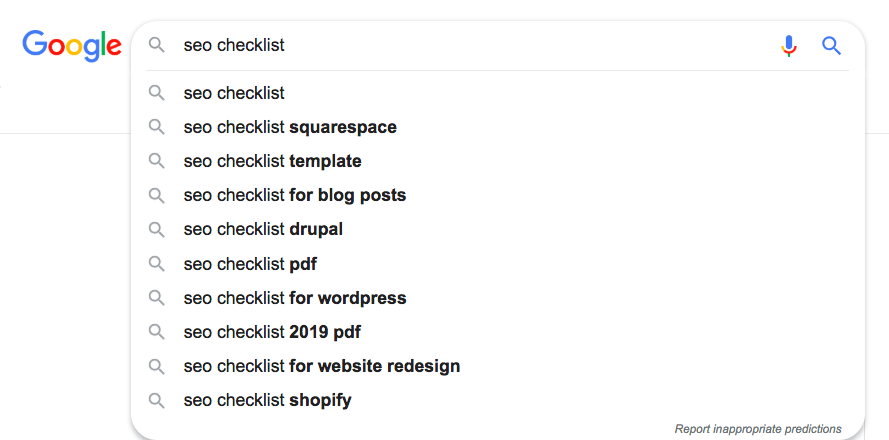
…the “People also ask” box that can push you in the right direction by providing you with questions that are related to your search…
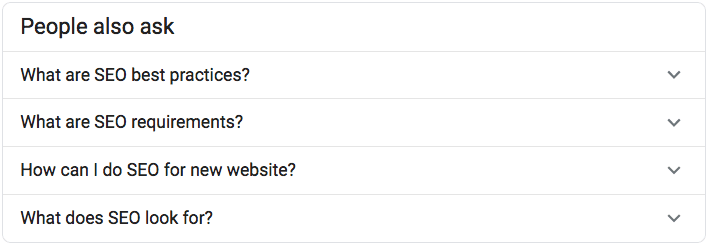
…and the “Searches related to…” section that shows keywords that are thematically-related to the entered search query.
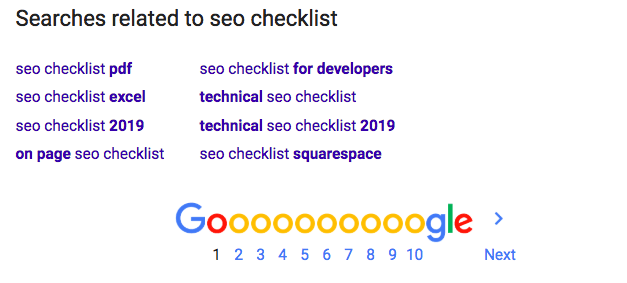
It will take a whole lot of manual work, but analyze the available data to figure out if there are any keyword ideas you can use on your site is a good starting point. On top of that, you can also get started with Google’s Keyword Planner and automatically get keyword suggestions.
If you’re looking to save time and automate this process, SE Ranking’s Keyword Suggestion Tool can provide you with a vast number of keyword suggestions along with data on their expected volume of traffic and level of competition. By the way, you’re welcome to sign up for a free 14-day trial and try it yourself.
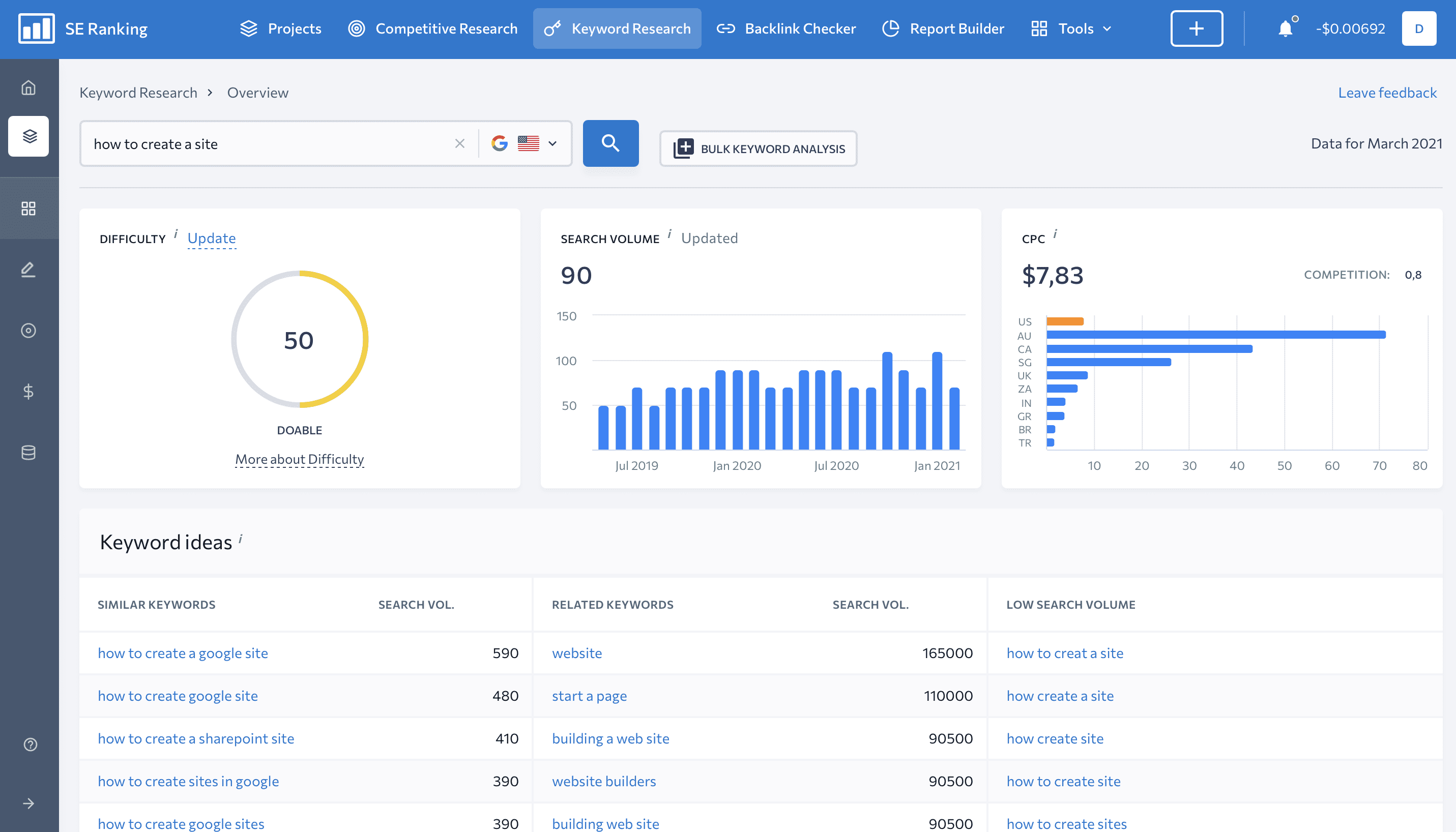
Just enter your target keyword and get plenty of Similar, Related and Long-tail keywords that are based on real human searches:
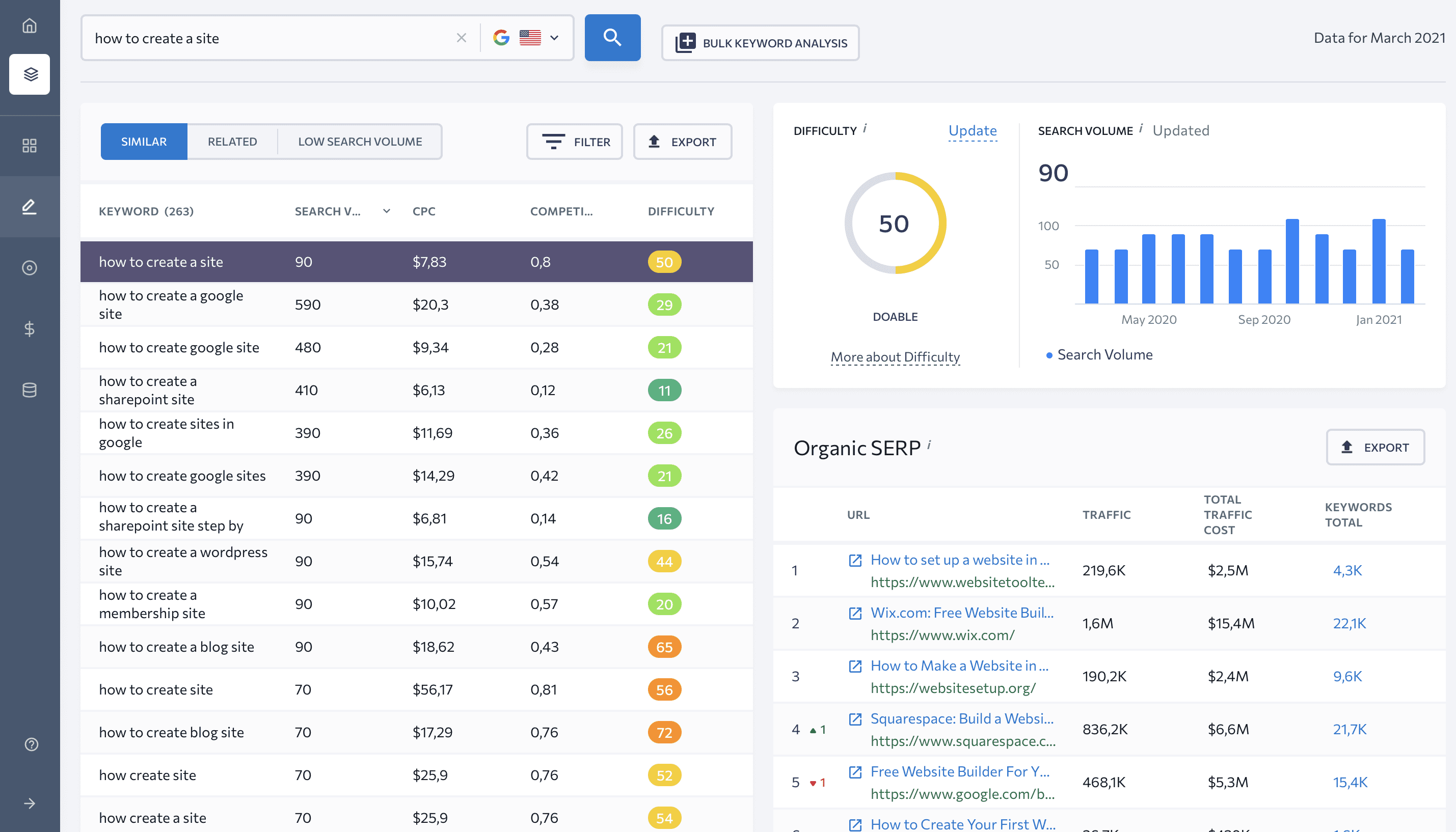
But remember that you have to set realistic goals when picking your keywords. As a rule of thumb, new websites can’t really compete with old or more established sites for popular terms, which is why it’s best to target long-tail keywords that have less competition.
To elaborate, here are the main criteria you have to keep in mind when choosing keywords:
- Match your topic. Is every collected keyword directly related to your product or service?
- Search volume. There are three keyword categories in terms of search volume frequency: long-tail (up to 500 monthly searches), mid-tail (up to 2,000 monthly searches), and short-tail (over 2,000 monthly searches.) While it is advised to focus on mid and short-tail keywords in promotion campaigns, there’s another parameter that can help you select the most promising keywords.
- Difficulty score. With the help of this parameter, you can get an understanding of how realistic it will be for your site to rank among the top search results by targeting a specific keyword. As a rule of thumb, new sites should be targeting less competitive search queries. To understand who exactly you will be going up against for top SERP ranking positions, click to view the detailed report under the Organic search results block and look at the pages that you will need to outrank.
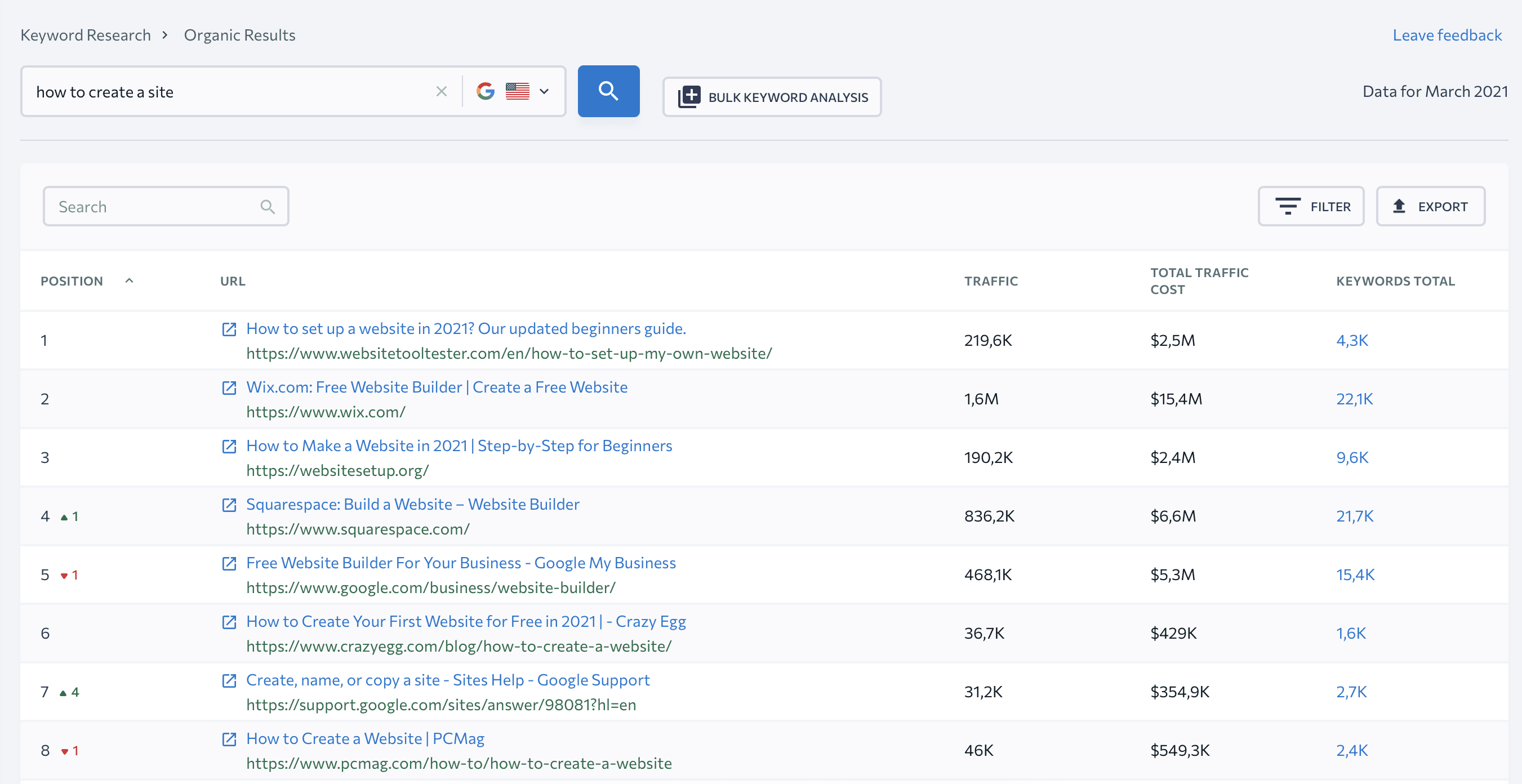
Put the two parameters—search volume and difficulty—side by side to choose the best keywords to target in your campaigns. For example, the search query “buy iphone” has a high search volume and is challenging to rank for. But although “buy iphone without contract” is a lot easier to rank for, it doesn’t get a lot of monthly searches.
With this data, you can come to a conclusion that you can get results with little effort by targeting the search query “buy iphone without contract”. Analyzing keywords like this helps you expand your keyword list with promising target keywords.


Pro Tip: Don’t just use the best keywords as-is in your campaigns. Think about the search intent and do your best to provide a solution to the problem. That way, you’ll help searchers solve their problems, and, at the same time, promote your website in search.
Get keyword ideas from competitors
If you run out of keyword ideas or don’t know where to start, spying on your competitors to find out what keywords they rank for is always an option.
With the help of SE Ranking’s Competitive Research tool, enter a competitor domain to discover the search terms that are driving traffic to their site. And if you see a search term that can potentially be beneficial to your site, just “borrow” it!
But don’t just pick a competitor that’s doing really well in the SERPs and has been around for a while—go for newer, less experienced websites. That way, you’ll be able to find keywords that you actually have a chance to rank for. If you do go after a top competitor, you’ll have an extremely difficult time trying to rank for their keywords.
If you don’t know who you’ll be going up against in the SERPs, choose several significant target keywords and analyze them using the Competitive Research tool to see what websites consistently rank for them—these are your rivals.
Develop a content plan
Once you have your keyword list ready to go, write out a content plan. Remember that ever since the Hummingbird update came out, you have to create content that’s unique and, foremost, relevant. Stuffing your copy with keywords simply won’t do the trick any more.
Each piece of content you publish must be:
- Unique. The more unique your content is, the more it’s valued by people and, in turn, search engines. For best results, it’s advised that you keep your content’s uniqueness rate over 90%.
- Readable. Your content must be scannable, digestible and easy to read for your target audience. Plus, it must have the same end goal: convey relevant information to your potential clients. When you create structured, scannable content, you make it easier for your message to get across.
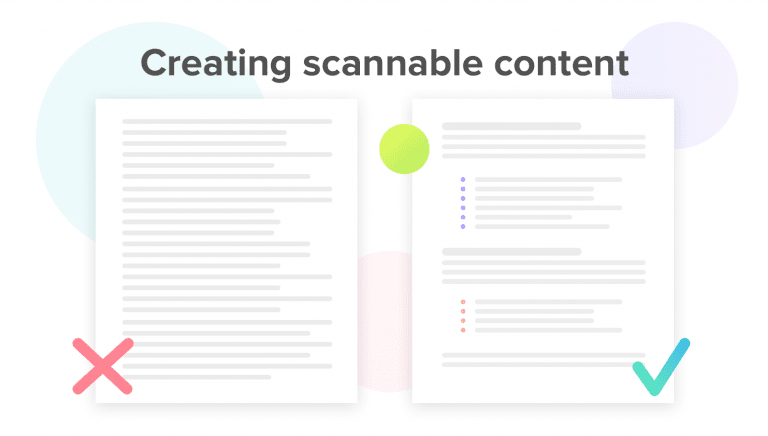
- Expert. Content is just as important as structure. So provide every possible detail on the subject at hand along with links to credible sources to satisfy visitor intent. Expertise is especially important for YMYL sites, since incorrect information can harm user health and/or their financial wellbeing. For this reason, search engines evaluate the expertise of YMYL content with extreme scrutiny. Content written by experts can also increase authority and trust among users which, in turn, means more people will come back to your site.
Keep in mind that the more expert, unique and complete your article is, the higher your site will rank in search and the better your product/service will sell.
But what about the content format?
Depending on your niche and business specifics, you have to decide on the type of content format you want to add to your website—a blog, infographics, videos, webinars, detailed product/service pages, presentations, case studies, etc.
Analyze your competitors to find out what types of content work best for them and think about what will work best for a new website such as yours. Perhaps, you already have all the content you need for the first few months. You don’t want to waste your budget on something that won’t bring in any results, right?
3. Optimize headings, title tag and description meta tag
Headings, the title tag, and the description meta tag are all important parts of a page that affect both its search ranking and the user experience.
Create relevant page title tags
Before searchers even get to see your site, there’s something else they’ll be able to see first in the SERPs. I am of course referring to the page’s title tag that’s displayed as a blue link, and is also used as the page’s heading if it’s shared on social media.
According to best practices, it is advised that you put the target keyword once into the title tag—preferably closer to the beginning—to let search engines know what the page is about. Plus, aim to create a title that will be different from the competition and entice searchers to click through to your site.
With SE Ranking’s Website Audit, you can stay on top of and review your page titles—see if they are attention-grabbing enough and if the right, unique target keyword is used. If there are any title-related issues, the tool will point them out and provide recommendations on how they can be fixed.
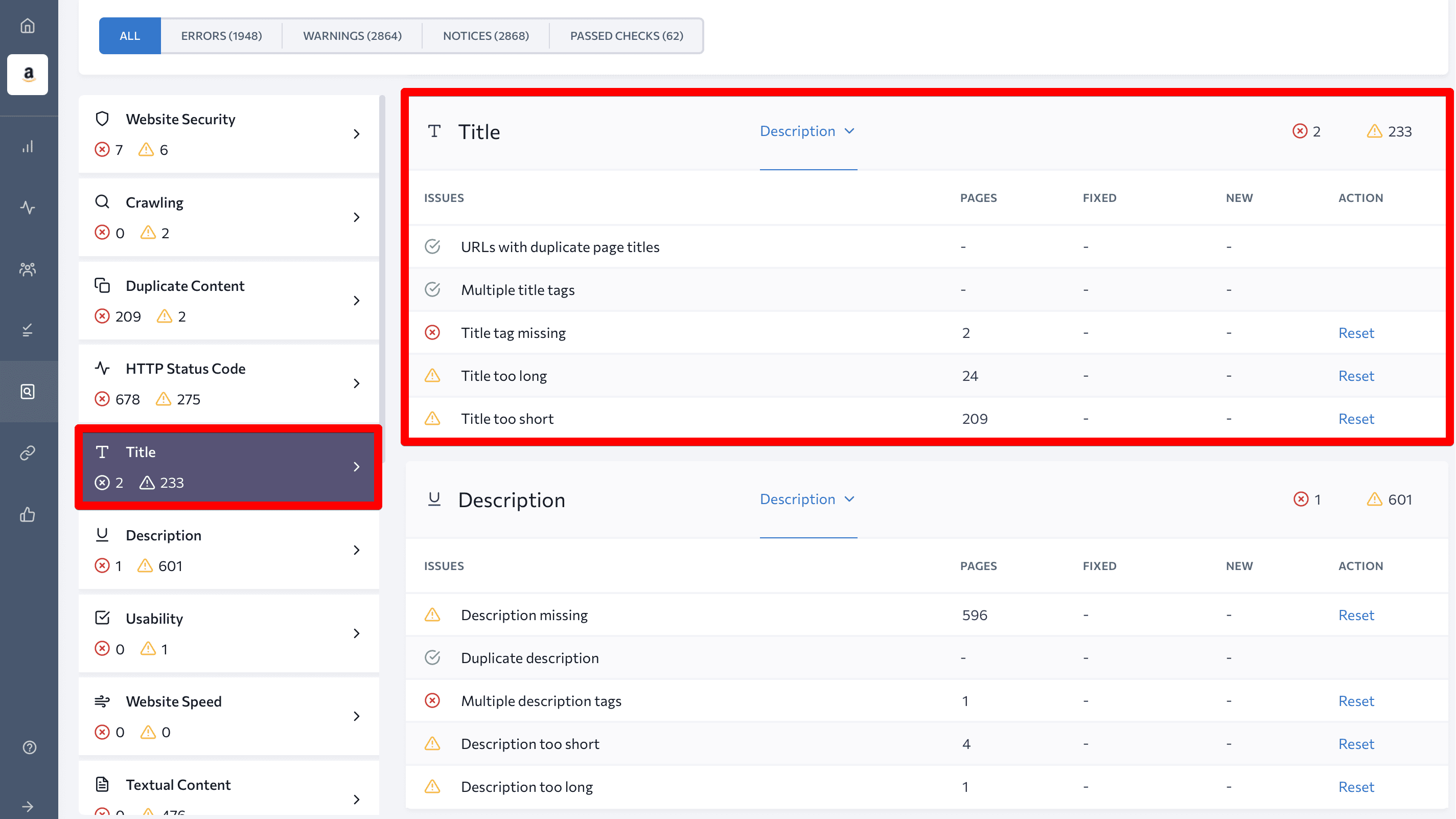
For example, find out if the title tag is missing on a page or if the same text is used in several title tags. Moreover, you can even set the range of the optimal length of the title tag to make sure they aren’t too long or too short.
Write catchy description meta tags
Just like the title tag, the page’s meta description can also help you boost your click-through rate, ultimately getting more eyes to look at your content.

The description meta tag is a brief summary of a page’s content. It serves as a piece of text that provides search engines with additional information and helps searchers understand what they’ll find on the page if they decide to click on it.
Think of it as an ad. This is where you can really get creative and stand out among other results. For this reason, make sure that your descriptions include the page’s target keyword and are as catchy as possible.
With the help of SE Ranking’s Website Audit, you can crawl every page of your website to check if it has a meta description, if the length of the description tag matches the suggested length, and whether there are any duplicates.
To see the exact text used in the description meta tag itself and the length of each description in characters, go to Crawled Pages.
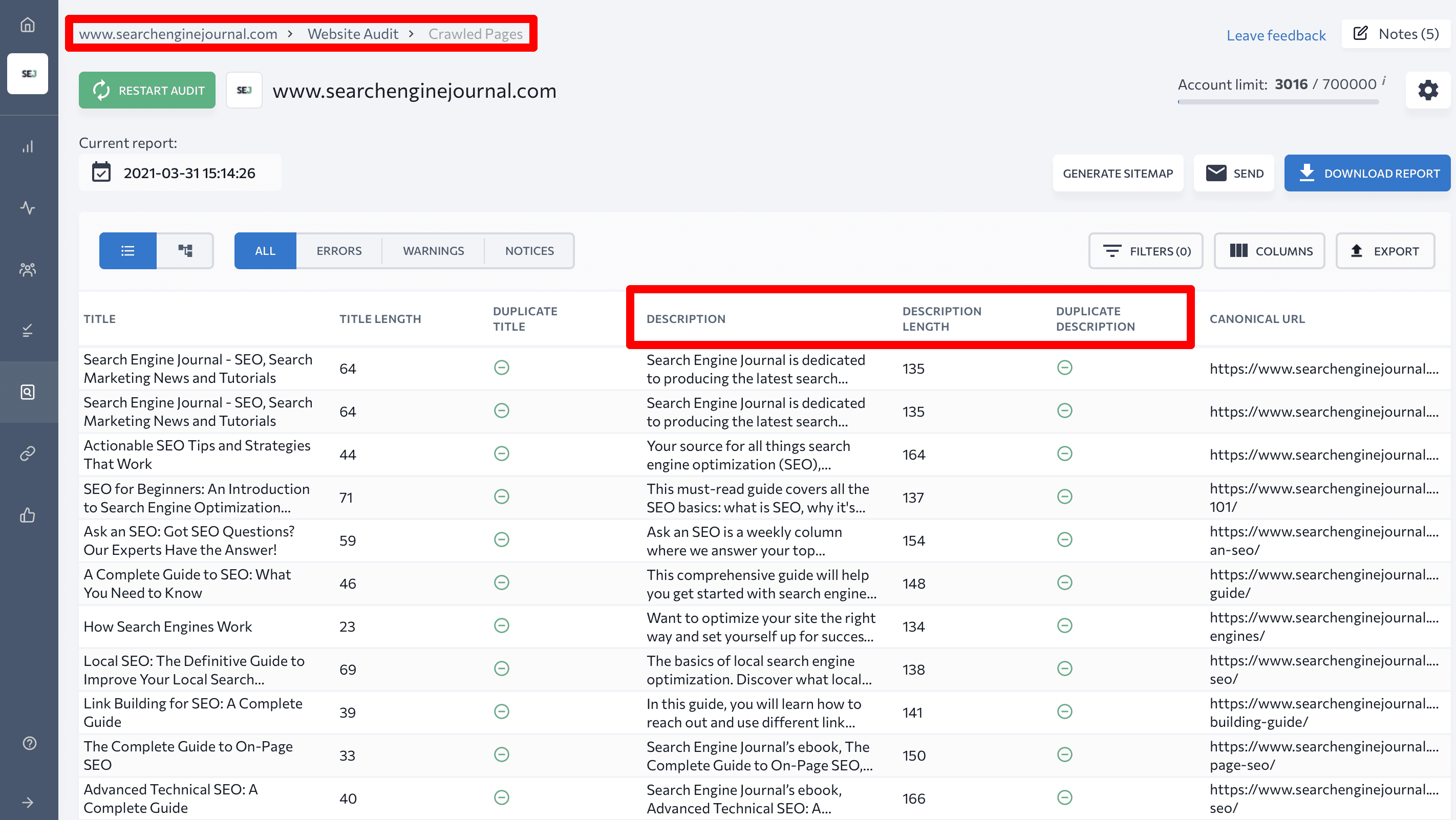
Create effective h1-h6 headings
In addition to the title, URL, and meta description, a web page’s main h1 heading tag also tells both search engines and people what the page is about, while h2-h6 subheadings give the page structure and make it more readable.
The main idea here is to create h1-h6 tags that organically fit into the page, accurately describe the content of the page and its individual sections.
I want to point out that under no circumstances should you stuff your headings with keywords. Plus, simply making your headers bold and larger than the rest of the text won’t do the trick, as search engines specifically look for those h* tags. Also keep in mind that you shouldn’t create a title and an h1 heading for the same page that contradict one another.
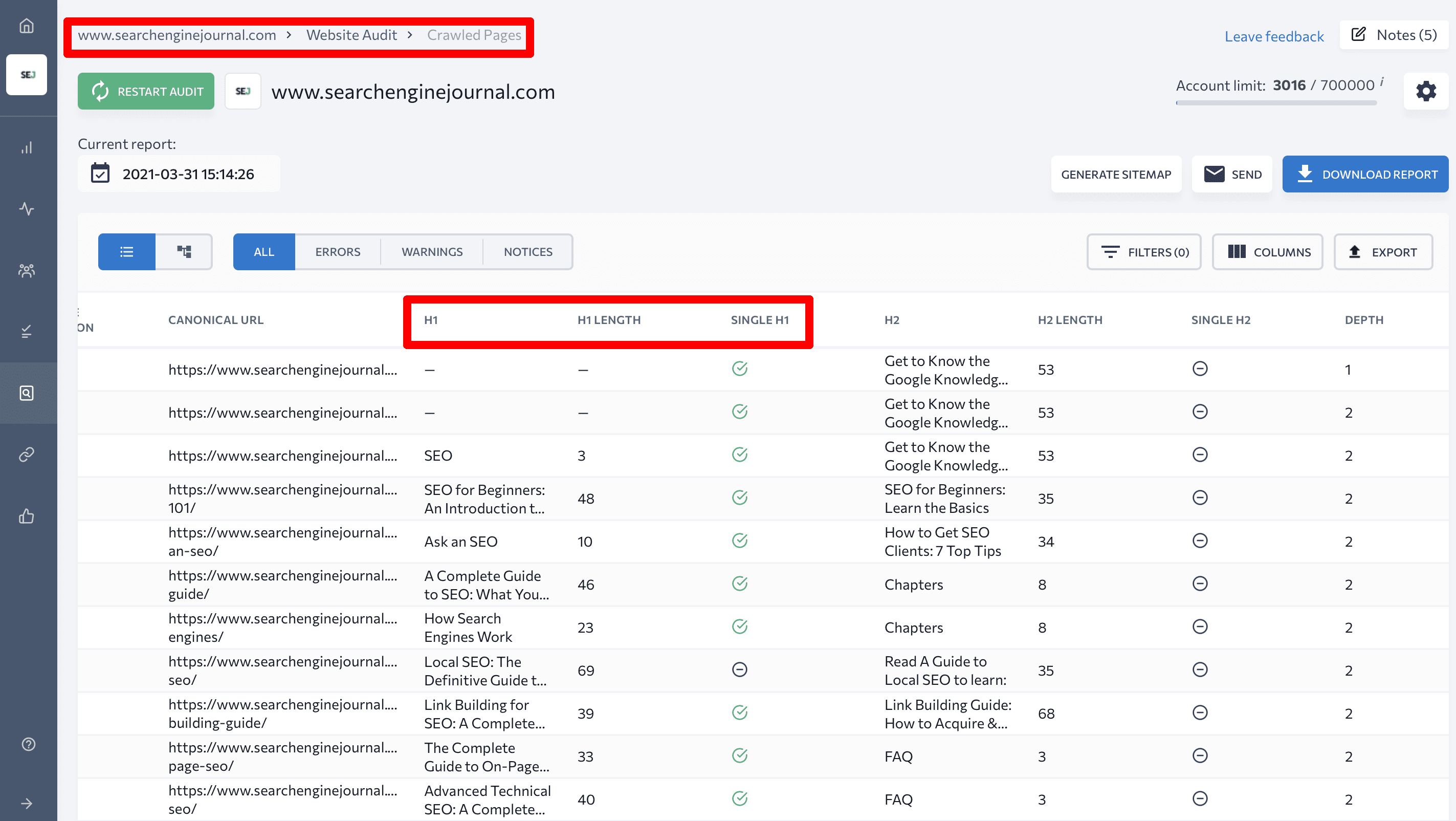
To keep tabs on all of your page headings, you can use SE Ranking’s Website Audit.
I strongly advise you to look at what your competitors are doing to get an idea of what kind of content works best. This will save you a lot of time and money. After all, why waste your budget on creating potentially ineffective content?
4. Optimize images
Not everyone knows that images can impact a website’s SEO and its overall usability. To get search engines to crawl and index your images better, consider the following best practices:
- The smaller an image size is, the better. Large image files can slow down the page loading speed.
- Unique images are always better than stock images. So if you don’t have the opportunity to ask a designer to create a custom image, you can make the images unique yourself.
- Use descriptive titles in the alt attribute and title tag, as well as in the file name to make it easier for search engines to determine what exactly is depicted on the image.
- Provide search engines with even more information by using semantic markup.
Find out more by reading our article on image SEO.
SE Ranking’s Website Audit can show you if you’re on the right track by pointing out images that should be optimized and those that don’t have any alt text.
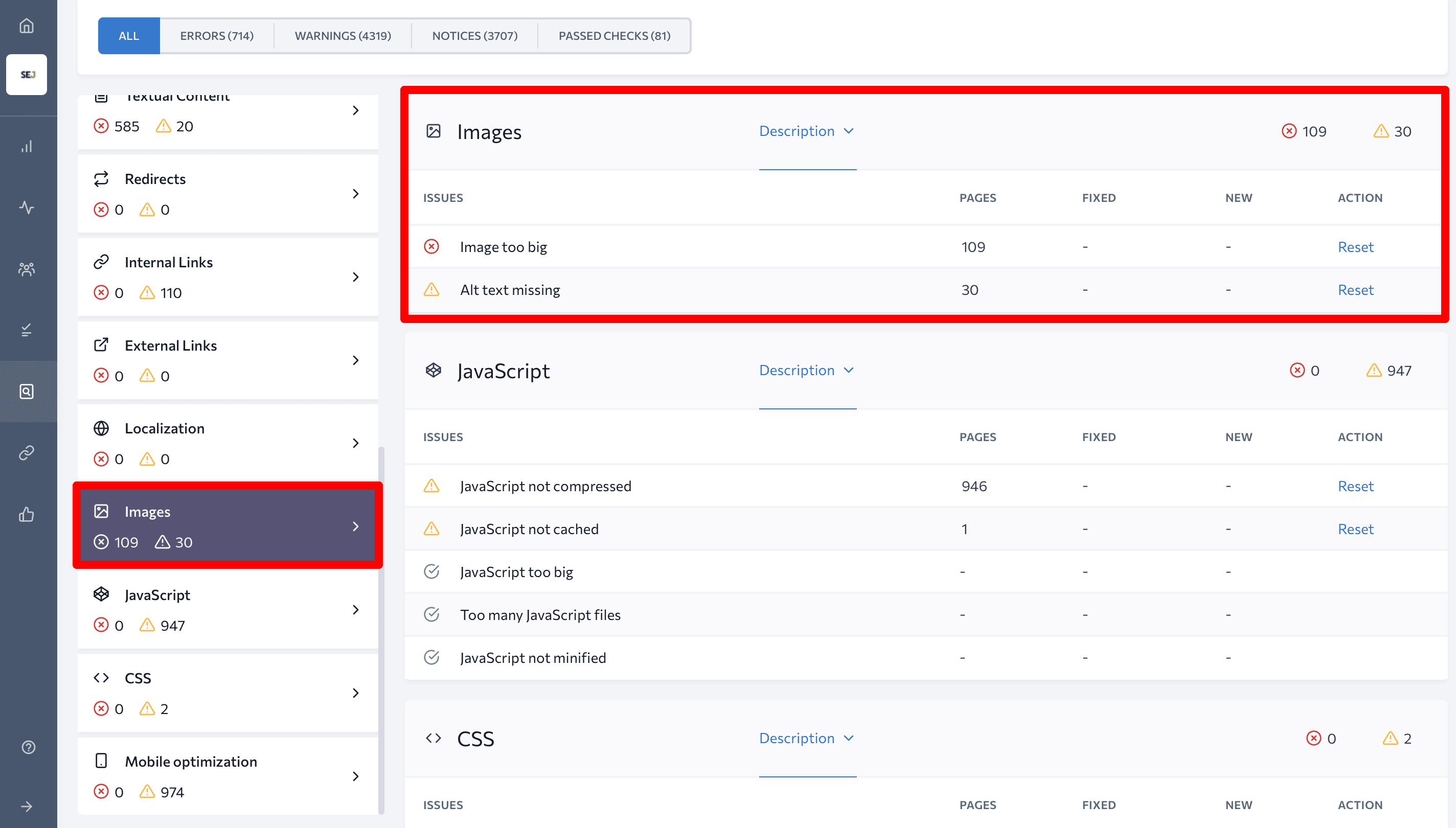
Pro Tip: If you built your website on WordPress, make use of the Shortpixel plugin to optimize your website’s images.
5. Boost loading speed and improve usability
Now that you know what your site’s content should look like, let’s take a look at a few technical aspects. Everything that’s happening behind the scenes of a site has a direct affect on the user experience. The main takeaway is that users have a strong dislike for pages that load slowly. For example, buttons start jumping across the screen once the page loads up, or worse, the page becomes completely unreadable on mobile devices.
In turn, search engines aren’t fond of slow pages either. Besides, Google has been adhering to the mobile-first indexing principle since 2020. What this means is that the search giant largely uses the mobile version of pages for indexing and ranking, and crawls such pages before moving on to pages that aren’t mobile-friendly. Plus, as of May 2021, Google rankings will also be influenced by Core Web Vitals.
With no time to waste, let’s figure out how to make your website fast and user-friendly.
Get your pages to load up quickly
Today, people hate waiting for anything and are used to seeing fast-loading pages. After all, slow pages have a high bounce rate, low conversion numbers, and if your site isn’t lightning fast, you don’t stand a chance of making it to Google’s first page.
The experience of users on pages, or page usability, is one of the most important ranking factors that includes several characteristics, including such Core Web Vitals as loading speed, interactivity, and visual stability.
To have positive Core Web Vitals, you should pay special attention to how quickly the first screen of the page loads up. For both users and search engines, it matters how long it takes before the first part becomes visible and can be interacted with. On top of that, it’s also important for page blocks not to move around too much as the page is loading.
Learn more about how you can improve the loading speed and page usability in our guide. But to give you an idea, here’s what you should do:
You can check if your site has any loading speed issues by analyzing it via the Website Audit tool and going to the Website Speed section of the Issues Report. Here you can also see if the site’s CSS and JS files are optimized.
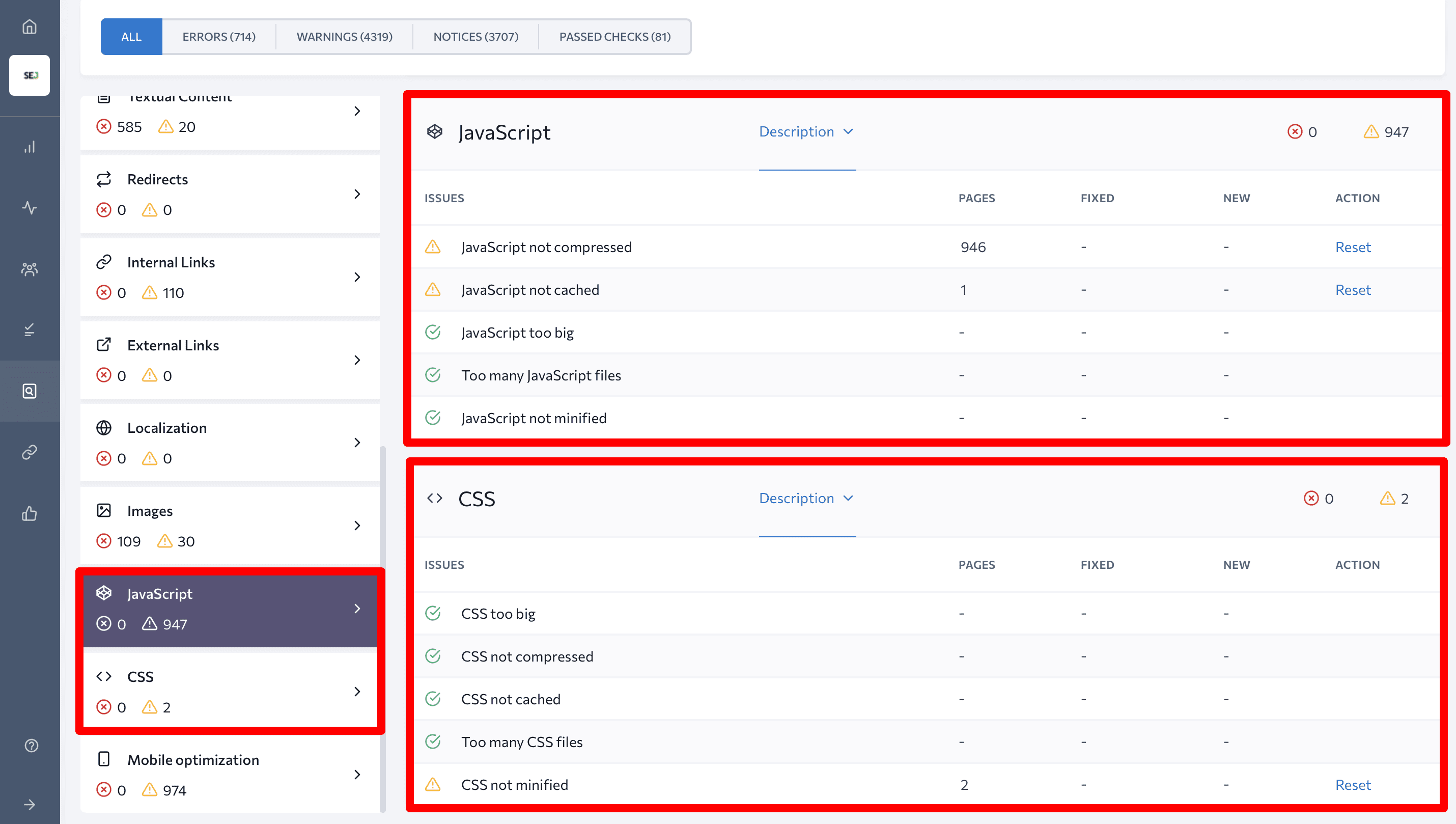
Make your site mobile-friendly
Nowadays, more searches are done on mobile devices than on desktops, making it critically important to create websites that provide an intuitive mobile experience. If a site isn’t mobile-friendly, users will be forced to zoom in on various page elements or even rotate the screen to see text or an image. At the end of the day, any visitor will eventually get tired of this and will head for the virtual door.
And since Google is all about giving users what they want, the search engine is looking to give a higher ranking to websites that work great on mobile devices.
Thanks to responsive web design, your website can adjust to the device it’s being viewed on. The best part is that you won’t have to create and promote separate pages on SERPs: one for mobile and another for desktop. Plus, all of the relevancy signals will be sent to just a single page, giving it more authority.
If you don’t know how much traffic you’re getting from mobile devices and from desktop computers, use the analytics services we covered at the beginning of this blog post. Even if the percentage of users visiting your pages from mobile devices is small, keep search engine recommendations in mind and optimize your site for mobile too, no matter what.
6. Make sure search engines can easily crawl your site
What should you do to get every important page of your site indexed? How can you tell if a web page is visible to search engines or when it’s closed off from indexing? Let’s figure out what helps search engines crawl and index your site, and what just gets in the way.
Create an XML sitemap
Search engine bots usually don’t crawl new sites that often because search engines don’t yet have a good understanding of the quality of the content that will publish and how often the publish button will be hit. To help search engines find all the important pages on your site, create an XML sitemap. The file should include every page you’d like to see in the index, with each page having a 200 response code, high-quality content, and being accessible to search bots.
The sitemap can also be used to let search engines know exactly when content was last updated and what page language versions there are. To improve the indexing of images and videos, you can also include them in your site’s XML sitemap.
The easiest way to create a sitemap is through your CMS. This will allow your sitemap to be dynamic, as in it’ll be updated automatically. You can also create an XML sitemap with the help of SE Ranking’s Website Audit tool. The tool give you the freedom to customize the settings and select a specific page type, define the last modification date and update frequency, as well as the crawl depth.
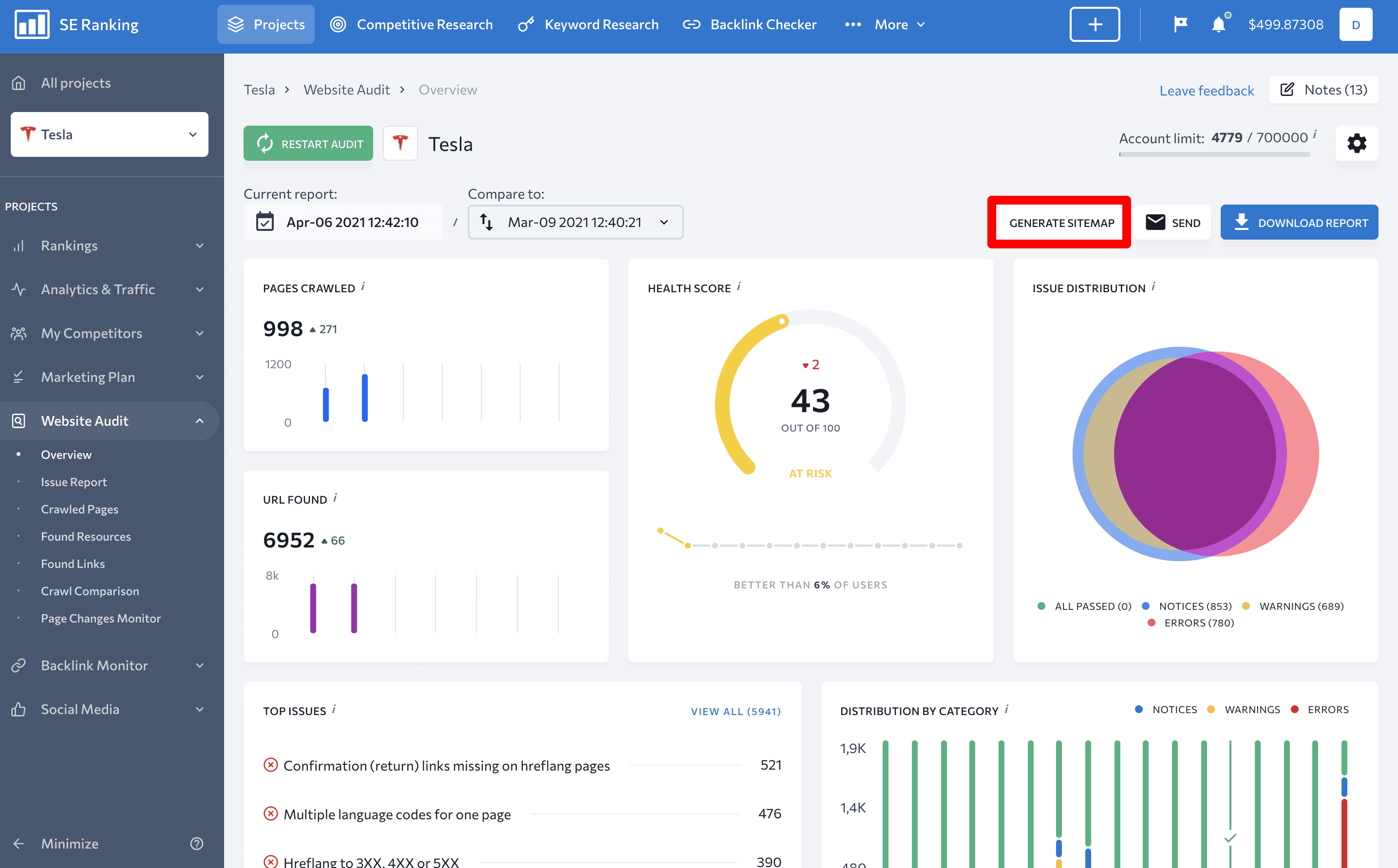
Then, you can upload your XML sitemap to Search Console or Bing Webmaster Tools, and monitor how many of your submitted pages are labelled as indexed to make sure you’re on the right track.
Create a robots.txt file
Every website needs a robots.txt file containing all the rules on how crawlers should engage with your website and where they can go. If Google doesn’t find your robots.txt file and sees a 404 page instead, it will scan all of your site’s pages. So, try to remember if there are any pages on your site that search engines don’t need to know about like pages with personal user data, search, sorting, and filter pages, or the admin dashboard.
If you do have pages that need to be hidden from search bots, add them to the robots.txt file, and house the file itself at [yourdomain].com/robots.txt.
If your site already has a robots.txt file, make sure it doesn’t block search engine bots from crawling your site’s pages. For example, webmasters deliberately close off pages that are in development so that they aren’t indexed ahead of time. Remember to remove restrictions in time and make sure you don’t tell bots not to crawl important pages of the site using the disallow directive.
You can check which pages are blocked by the robots.txt file by going to the Crawling section of the Website Audit tool.
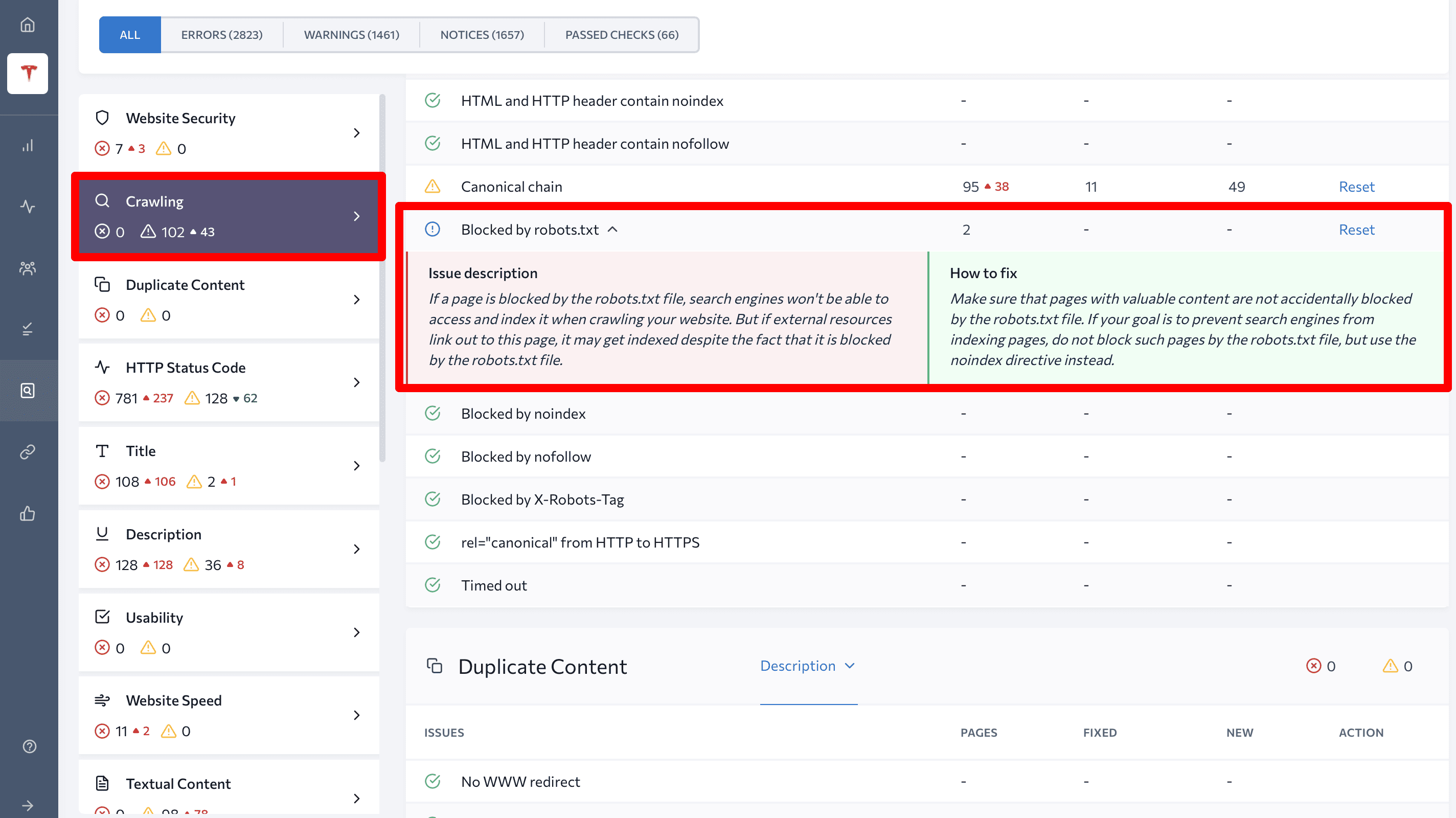
Check robots meta tag and the X-Robots tag directives
In addition to directives in the robots.txt file that can prevent search engines from crawling your site’s pages, there are also noindex and none directives in the page HTML code or HTTP header. Once bots start crawling your site, these directives tell search engines that there is no need to index a given page.
Duplicate, landing, technical and outdated pages can harm your site. For this reason, they are usually closed off from indexing. As a rule of thumb, this is done by the developers, and if you did not instruct them to close some pages off using the noindex tag as the site was being built, you shouldn’t have any problems with this directive.
Nevertheless, it’s worth checking if the directive is used on the site because you never know when a developer will accidentally close off an important page from indexing. To do this, go to the Crawling section of the Website Audit tool.

7. Start building up your backlink profile
What’s the big deal with links? Well, they connect everything on the internet and it’s how we go from one site to another. When a website with high authority links out to you, the link acts as a citation that proves to search engines that the linked-to page has relevance, authority and value.
Once you get the hang of it, there are plenty of ways you can go about building backlinks to your website, but let’s see what you can do with a new site.
Analyze competitor backlinks
Since you’re just taking your first steps, you don’t have any backlinks yet. So, where do you start?
Take a look at the websites that link out to your competitors using SE Ranking’s Backlink Checker. Just enter any competitor domain and get a list of every single backlink:
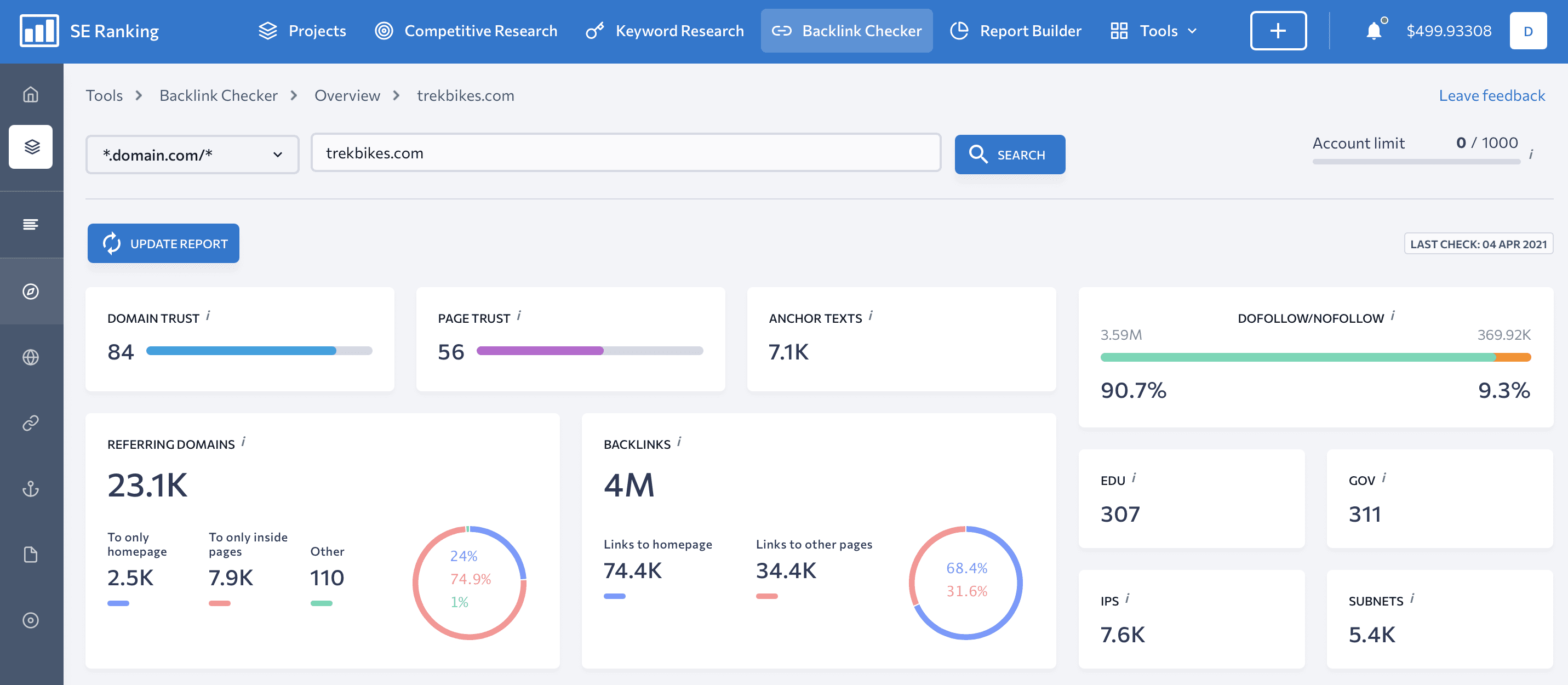
By carefully studying the backlink profiles of your main competitors, you can get new ideas, learn what backlinks they have, how they got them, how authoritative the backlinks are, and devise a link-building strategy of your own based on their experience.
But I want to warn you that you shouldn’t just attempt to copy the entire backlink profile of a competitor—you’ll fail to do so 99 times out of 100.
What you should pay attention to more as you’re planning your link-building strategy is not your competitors, but the specifics of your business. Think about the links that will benefit you more and which ones can be obtained more easily. Perhaps, you already have a client or a partner you can get a couple of backlinks from.
Design a link-building strategy
As was touched on earlier, to start building backlinks, you need to first create awesome content that people will want to link out to. Stats, listicles, videos, and infographics get the most amount of backlinks, but you’ll have to figure out what works best for you on your own.
Before you start writing great content, set realistic goals in line with your marketing strategy. It also makes sense to find out where your audience spends their time online to understand the kind of content they like best and provide them with it. And plan well ahead as link-building is a lengthy process that will take a whole lot of time to produce results.
Since you don’t have any links yet, your main goal is to start off on the right foot. Hand-pick authoritative websites, write out clear, relevant anchor texts, and don’t rush the process! Google assesses your overall backlink profile and is able to spot it if you obtain too many links too quickly, which can lead to manual sanctions. So be extra careful.
Furthermore, since getting your first backlinks is a rather difficult task, you must play your cards right and select several important pages from your site—including the homepage—that you will build backlinks to. That way, you’ll boost your chances of getting links to key pages.
Additionally, ever since Google’s Penguin Update came out, backlinks of poor quality aren’t even taken into account and only quality backlinks give your website more relevance, authority and value. So, several high-quality links can do so much more for your SEO than hundreds of poor ones.
Keep the SEO train rolling
To recap, I want to stress that this is not a set-it-and-forget-it situation. SEO requires constant hard work from day one. If you don’t think about SEO now, all of the hard work you put in will be discarded as soon as Google indexes your website. But remember to be patient because it can easily take upto half a year for your SEO activities to show results.
When creating a website, make sure your site loads up quickly and displays everything correctly on any device. To boot, do proper keyword research, think the site structure through, and start filling it with quality content. Of course, verify that search engines can crawl and index your pages. Besides the sitemap, backlinks can also help search engines learn about your new website. Plus, links from quality sites increase page rankings in the eyes of Google.
All these steps are important if you’re serious about gaining the trust of users and search engines to, hopefully, improve your SERP standings. Sure, doing keyword research or improving the site’s technical indicators is by far an easy task.
So, if you need more information in order to understand certain aspects of doing SEO for a new site, follow the links in this article and check out the detailed guides as well. I will also be happy to answer any questions you leave in the comments section below. So strap yourself in and good luck!
Post Views: 2,331
